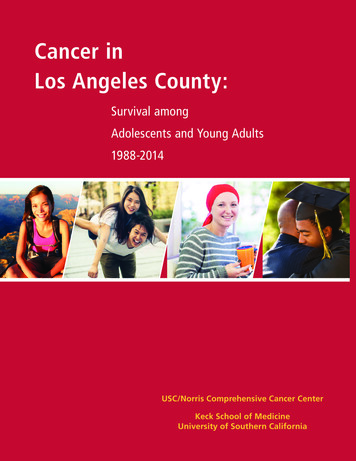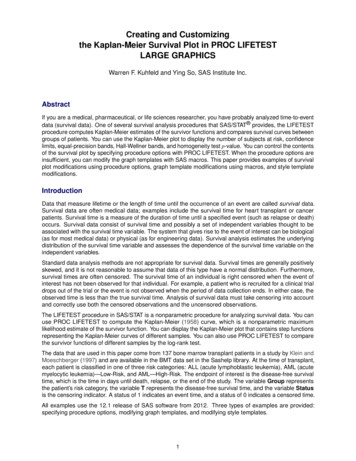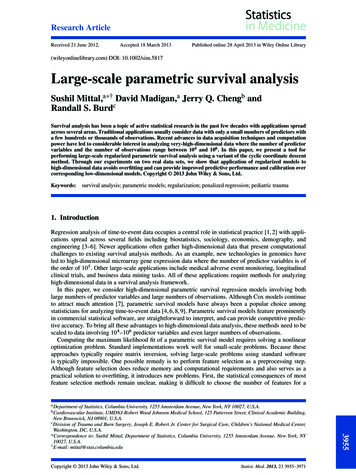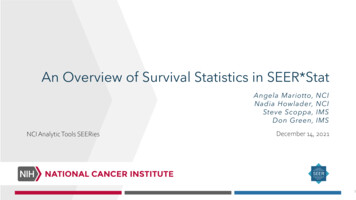
Transcription
An Overview of Survival Statistics in SEER*StatAngela Mariotto,Nadia Howlader,Steve Scoppa,Don Green,NCI Analytic Tools SEERiesNCINCIIMSIMSDecember 14, 20211
1. Overview of survival2. Relative Survival RatesAgenda Period Survival Conditional Survival3. Demos of relative survival and theperiod method4. Cause-specific Survival5. Crude survival (Crudeprobabilities of death)6. Demo 32
Cause-specific survivalNCI Analytic Tools SEERies
Challenges in Relative Survival Relative survival assumes life tables are representative of the cancercohort’s other causes mortality General population life tables may not represent well the ‘other causemortality’ for: Ethnic minorities, Cancers affected by common risk factor affecting other diseases (e.g. lungcancer and smoking) Screen-detected cancers (local stage breast and prostate cancers) relativesurvival may be higher than 100% Although relative survival is the default, SEER uses cause-specific survivalto show survival by detailed race/ethnicity4
Examples of Relative survival being problematic(Table 4 Howlader et al JNCI 2010)5
Examples of Relative survival being problematic(Table 1 Forjaz et al CEBP 2019).6
Cause-specific survival (Uses cause of death) Deaths associated with cancer event of interest Deaths due to other causes censoring event Net survival measure (in the hypotheticalworld that patients do not die of othercauses)7
SEER Cause-Specific Death Classification Variable SEER algorithm to improve cause of death indicator: For cases without a prior history of cancer (Howlader et al, JNCI 2010) For cancer patients with a prior cancer (Forjaz et al, Cancer 2021) The algorithm takes into account COD in conjunction with Site of original cancer diagnosis Tumor sequence (the only cancer or the first of more than 1) Diseases related to the cancer of diagnosis (e.g., HIV/AIDS) Cause of death was evaluated using respective International Classification ofDisease Codes (ICD): ICD-8 (1973-1978), ICD-9 (1979-1998), ICD-10 (1999 ) For more details: http://seer.cancer.gov/causespecific/index.html8
Cancer patient Survival with and without A PriorCancer (Table 2 Forjaz et al Cancer 2021)9
SEER*Stat Cause- specific survival (Life page)1-year Cause Specific Survival 67.0%1-year Relative Survival 65.3%10
Cause-specific survival vs. Relative survivalsummary Both methods involve assumptions specific to the approach Cause-specific: Accurate classification of cause of death Relative: Appropriate estimation of expected survival In most situations relative and cause-specific survival are similar (Howlader etal JNCI 2010, Forjaz et al CEBP 2019) Each study should be evaluated in terms of the more appropriate underlyingassumptions Comparative population-based studies usually use relative survival becauseof difference in the quality of cause of death information11
Crude survival or competing risk survivalProbability of dying of cancer, dying of other causes and survivingDecember 14, 202112
Crude survival measure: patient prognosisExample: Patient with cancer and cardiac conditionsCancer SpecialistIs the chance of dying ofother causes small enoughto aggressively treat thecancer?CardiologistIs the probability of dyingfrom the cancer smallenough toaggressively treat thecardiac condition? Patients do not live in a hypothetical world: they can die of other causes13
Crude Probabilities of Death (survival undercompeting risks) Measure of the mortality patterns that are actually experienced in acohort of cancer patients Better measure for treatment decisions since it includes risk of dyingof other causes It is calculated and reported as: Probability of surviving Probability of dying of cancer Probability of dying of other causes14
Methods for Calculating Crude Probability ofDeath in SEER*Stat Using expected survival Does not rely on cause of deathinformation and uses life tables toestimate expected survival (Cronin& Feuer, 2000). Using cause of death information Similar to multiple decrement lifetables (Marubini & Valsecchi, 1995;Schairer et al., 2004, Howlader etal, JNCI Monograph 2014)15
Crude probabilities of death using cause of deathinformation Probability of surviving 43.1% Probability of dying of cancer 51.4% Probability of dying of other causes 5.5%16
question 1- relative survival Net probability of dying of cancer What do you expect to be bigger: (a)Net probability of dying ofcancer or (b) crude probability of dying of cancer?17
Comparison of net and crude survival: colorectal cancerpatients diagnosed with regional stageYoungerOlder(Age 45 at cancer diagnosis)100%5-year probability (%)80%26%die fromcolon cancer25%die fromcolon cancer60%40%(Age 85 at cancer diagnosis)100%80%46%die fromcolon cancer41%die fromother 37%40%54%survivaldie fromcolon tualCrudeprognosisSurvival18
Comparison of Cancer and Actual prognosis: colorectal cancerpatients diagnosed with regional stage age 66 Comorbidity information only available for ages 66 5-year probability (%)100%80%60%40%20%0%No ComorbiditySevere Comorbidities(score 0)(score 639)35%die fromcolon cancer65%survivalCancerprognosisRelative Survival14%32%die fromcolon 44%die fromcolon cancer56%survival34%die fromother causes35%die fromcolon ative Survival19
Summary of Methods andMeasures20
html21
Net Vs crudeNetSurvival measure notaffected by changes inother-cause mortalityCRUDESurvival including the risk ofdying of other causes(competing risks)Measures how quicklyprogress in clinicalresearch is transferredinto clinical practiceMeasure mortality patternactually observed in cancerpatientsCancer progress- PolicymeasurePrognosis survival measures Both can be calculated in the relative or cause-specific methods22
Different Types of Questions different survivalstatistics Patient 1: I have just been diagnosed with ovarian cancer. Whatare my chances of surviving this cancer? Patient 2: I have cardiovascular disease and have beendiagnosed with localized breast cancer, what are my chances ofdying of breast cancer in the next 5 years? Science Writer: How has survival of prostate cancer changed overtime? How do you expect it to change in the future? Congressperson: What is the most recent estimate of 5-yearsurvival for breast cancer? How does it differ by race/ethnicity? Cancer Survivor: I have survived five years after diagnosis withcolorectal cancer. What is the possibility that I am cured? Whatare my chances of not dying of cancer in the next 5 years? Researcher: Do cancer patients have higher risks of death forother causes (in the absence of cancer death) compared to thegeneral population?23
Different Types of Questions different survivalstatistics Patient 1: I have just been diagnosed with ovarian cancer. Whatare my chances of surviving this cancer? Patient 2: I have cardiovascular disease and have beendiagnosed with localized breast cancer, what are my chances ofdying of breast cancer in the next 5 years?Crude (or Net)Crude Science Writer: How has survival of prostate cancer changed overtime? How do you expect it to change in the future?Net (Relative survival) Congressperson: What is the most recent estimate of 5-yearsurvival for breast cancer? How does it differ by race/ethnicity?Net (Relative Survival) Cancer Survivor: I have survived five years after diagnosis withcolorectal cancer. What is the possibility that I am cured? Whatare my chances of not dying of cancer in the next 5 years?Crude (or Net) Researcher: Do cancer patients have higher risks of death forother causes (in the absence of cancer death) compared to thegeneral population?24
www.cancer.govwww.cancer.gov/espanol
survival. 46%. die from colon cancer. 37%. die from colon cancer. 41%. die from other causes. 0% 20% 40% 60% 80% 100% Cancer prognosis Actual prognosis. Younger (Age 45 at cancer diagnosis) Older (Age 85 at cancer diagnosis) Relative Survival Crude Survival Relative Survival Crude Survival
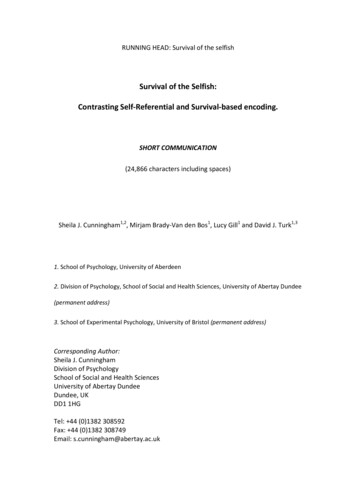
![[ST] Survival Analysis - Stata](/img/33/st.jpg)




